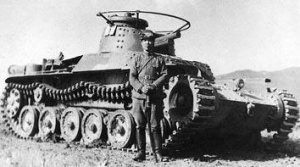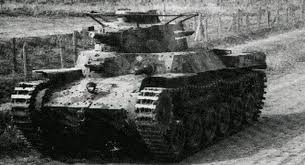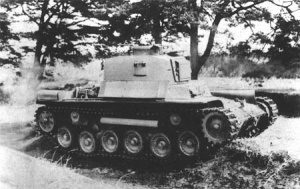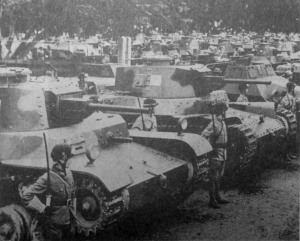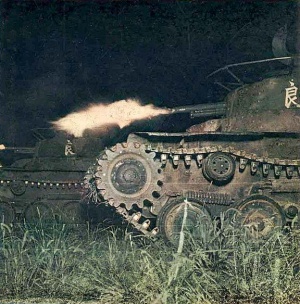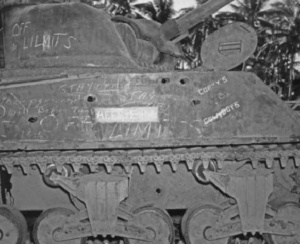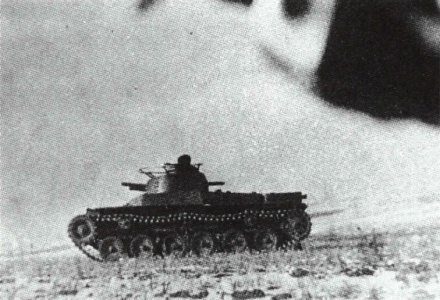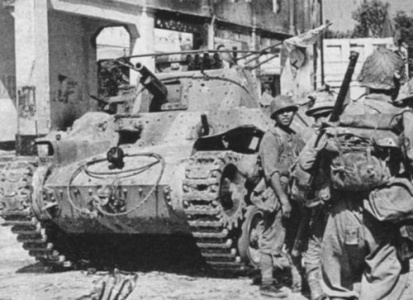Chi-Ha (Family)
Description
The Type 97 Chi-Ha (九七式中戦車 チハ, Kyūnana-shiki chū-sensha Chi-ha) was a medium tank used by the Imperial Japanese Army during the Second Sino-Japanese War, Soviet–Japanese border conflicts, and the Second World War. The tank was the most produced Japanese tank during the Second World War.
The Chi-Ha's low silhouette and semicircular radio antenna on the turret made the tank very recognizable from its contemporaries. Because of the Navy having resource priority, the Army had to keep this rather fast becoming outdated tank in service, which got a turret overhaul in 1942 allowing for a third turret crewman and a Type 1 47 mm anti-tank gun. This remodel got the designation Type 97-Kai (Improved) or Type 97 ShinHoTo Chi-Ha (Improved turret).Vehicles
Rank I Vehicle
Rank II Vehicle
History
Design
The Type 97 Chi-Ha was a medium tank constructed with rivets in the armour plates. It had a crew of four with a two-men turret. Armour was relatively thin, but quite standard at the time of 1930s. The first main gun on the Chi-Ha, being the Type 97 57 mm tank gun which was a slighter longer barrel than the Type 90 57 mm tank gun that was mounted on the Type 89 I-Go medium tank and used in an infantry support role. The bell crank suspension was the same as on the Type 95 Ha-Go light tank, but due the Chi-Ha having an longer hull, the suspension as well had to be elongated and got 6 road wheels instead of four. With the addition of these 2 new road wheels, made the Chi-Ha more stable in a hilly environment which was an issue on the Type 95 Ha-Go.
Development
Type 97 Chi-Ha
As the Type 89 I-Go has seen its use in Manchuria and the problem of not being able to keep up with the motorized infantry, a replacement program by the Imperial Japanese Army has started in the late 1930's. The plan for the new tank was to be a up-scaled version of the 4 man Type 95 Ha-Go light tank, with thicker armor and a more powerful engine to keep up with motorization.
As the Tokyo Plant of Mitsubishi Heavy Industries & Osaka Army Arsenal start their prototypes for the Army requirements, with Mitsubishi developing the more expensive Chi-Ha and Osaka the cheaper, lighter Chi-Ni.
Even though the requirement of the gun was to be a 47 mm, both Mitsubishi & Osaka Army Arsenal outfitted their tanks with the 57 mm found on the Type 89B I-Go Otsu.
As the Second Sino-Japanese War broke out on the 7th of July 1937, the peace-time budget limits have been removed. Because the Army now has a larger budget, they chose for the more expensive and capable Chi-Ha by Mitsubishi and was adopted in to service as the Type 97 Medium Tank Chi-HaType 97 Chi-Ha Kai
As the Soviet–Japanese border disputes continue, the Chi-Ha has been put in service on the borders. Their first major encounter against other tanks were during the Battles of Khalkhin Gol. The low-velocity Type 97 57 mm gun on the Type 97 started showing its weakness as the faster and better gunned Soviet BT-5 and BT-7 out-ranged and out-maneuvered the slow turning & short range turret of the Chi-Ha. Due this shortcoming, it resulted to heavy Japanese losses.After hearing of these losses the Army was looking for a more powerful gun. The development of a new 47 mm anti-tank gun began in 1939 and was completed by 1941. This new gun specifically designed to counter Soviet tanks, was adopted as the Type 1 47 mm anti-tank. The longer barrel of this 47 mm creating a lot higher muzzle velocity and resulted in greater armor penetration which far surpassed that of the 57 mm gun.
As this gun was to be put on the Chi-Ha, a new turret was designed, which allowed for the Type 1 47 mm tank gun to be mounted and a 5th crew member as loader. This variant of the Chi-Ha would be designated as Type 97-Kai ("improved") or ShinHoTo Chi-Ha ("New turret" Chi-Ha"). The new Type 97 Medium Tank Chi-Ha Kai would fully replace the regular Type 97 Medium Tank Chi-Ha in 1942. Additionally about 300 regular Chi-Ha's were converted with this new turret.Further Development
Like most other countries having a main medium tank, the Japanese adapted the hull for a multitude of roles and variants to be used in other purposes. The Type 97 was improved plenty of times with field guns, command variants & engineering variants. Near a hundred self-propelled guns were built upon Type 97 chassis.
As the gun power of 1930s Japanese tanks were rather lackluster and weren't able to reliably penetrate the 1940s generation of Soviet, American & British armor, the need of tank destroyers rose, gun ranging from 47 mm up to 127 mm guns were tested upon. But due the Navy's priority, raw materials for the Army's production was limited, and building new guns or tanks was nearly out of question.
The last Japanese tank directly based on the Type 97 lineage should be the Type 3 Medium Tank Chi-Nu which got the improved Chi-Ha hull from the Type 1 Medium Tank Chi-He but with a totally overhauled hexagonal turret and commander's cupola with a 75 mm gun.Combat History
As the first production of Chi-Ha's were finished, they were all moved to the Chinese front to support the infantry, and deal with the weaker tank force of Chinese imported Vickers, Panzer I's & CV33's. As under command of Hideki Tojo, who ignores the lessons they got out of previous tank usage under the Japanese army in 1933 (Battle of Rehe) and spreads out the tanks in a more infantry focused attack, which made battles where the Chinese had actual anti-tank guns a very though battle for the Japanese with spread out, lightly armored tanks. Hence this failure of tactic, the funds for tank production was cut down and tank brigades essentially shut down.
The first real combat test of the Chi-Ha happend during the Battles of Khalkhin Gol, Nomonhan. Where the more successful combined arms force of the Soviets showed the weakness of Japanese infantry tanks as where the Chi-Ha with short 57 mm was out-ranged & -gunned by the Soviet BT-5's & BT-7's.
For this incident & successes of the Blitzkrieg tactic of the Germans in Europe, the Japanese started re-evaluating tank tactics & developments. (Leads to Development: Chi-Ha Kai)
Though this came little too late, as the Navy got resource priority due the Chinese front coming to a stalemate, the expansion in South Asia and beginning of World War II for Japan as the Navy bombs Pearl Harbour.
World War II
As the war shifted in to a more island hopping campaign, the Army successfully used the Type 97 Chi-Ha's during the Battle of Singapore & Malaya. Due the light weight of the Japanese tanks, they could easily exploit through the wet & thick jungles and attack the British from areas where they never expected to see any tanks coming from and effectively never placed defense lines upon. Same tactics & movements of the Chi-Ha's was used during their campaign in Burma.
The first use of the Chi-Ha Kai was during the Battle of Corregidor. The new 47 mm made to have a more general tank role truly shined here and easily dealt with the armor of the American M3 Stuart light tanks.
But as the war progresses, the date of the Chi-Ha started catching up, still in a position of not being able to create better tanks with the production priority of the Navy, the Japanese capable tanks of the 30's, started facing the American 40's tank, the M4 Sherman, and due this production limitation the Chi-Ha and other Japanese tanks were viewed upon as bad designs and incompetent tanks. As they misinterpret these outdated tanks as Japan's 40's tanks.
With the M4 Shermans being a big problem for Japanese tanks, where the most front-line capable tank of taking them out, being the Chi-Ha Kai, was still only able to penetrate from either against the sides and rear.
The largest Japanese tank attack in the Pacific happend during the battle of Saipan, where Type 97's & Type 95s from both a tank & infantry regiment charged an all-out counter attack on the night of 16-17 June. As the Americans already landed the day before, the Americans were fully prepared for a counter charge and knocked out about 44 tanks with the use of M4A2s, several M3 GMC, M1 Bazookas and 37 mm anti-tank guns. As this attack was futile, this led to many Japanese losses.
From this moment on, all hope was lost for the outdated tanks which still had to see combat through, and most tanks would be used in a defensive position being emplaced in hull defilades or even buried up to their turrets.
After World War II
Some Japanese tanks, after being captured by Soviet troops during the Soviet–Japanese War in Manchuria and Korea, were given to the Chinese Communists to help their effort in the Chinese Civil War. After their war, the Chinese kept the Japanese tanks in their inventory until 1949.Variants (In-Game)
Medium Tanks
- Type 97 Chi-Ha
- Type 97 Chi-Ha Kai
- Type 1 Chi-He (Successor)
Gun Tank
- Type 97 Chi-Ha Short Gun (Navy Gun Tank remodel)
SPG's
- Type 1 Ho-Ni I (Remodel to fit a Type 90 field gun on a Chi-Ha)
- Type 3 Ho-Ni III (Anti-Tank refit of the Ho-Ni Series)
- Type 4 Ho-Ro (Remodel to fit a Type 38 howitzer on a Chi-Ha)
Media
- Chi-Ha Kai Destroyed.jpg
Battle for Iwo Jima, February-March 1945.


